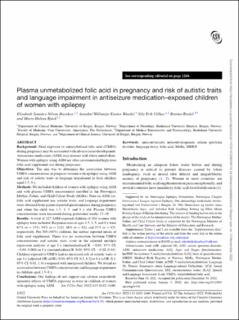| dc.contributor.author | Husebye, Elisabeth Synnøve Nilsen | |
| dc.contributor.author | Wendel, Annabel Willemijn Karine | |
| dc.contributor.author | Gilhus, Nils Erik | |
| dc.contributor.author | Riedel, Bettina Maria Ingeborg | |
| dc.contributor.author | Bjørk, Marte-Helene | |
| dc.date.accessioned | 2022-11-30T08:39:46Z | |
| dc.date.available | 2022-11-30T08:39:46Z | |
| dc.date.created | 2022-10-19T13:41:52Z | |
| dc.date.issued | 2022 | |
| dc.identifier.issn | 0002-9165 | |
| dc.identifier.uri | https://hdl.handle.net/11250/3034901 | |
| dc.description.abstract | Background: Fetal exposure to unmetabolized folic acid (UMFA) during pregnancy may be associated with adverse neurodevelopment. Antiseizure medication (ASM) may interact with folate metabolism. Women with epilepsy using ASM are often recommended high-dose folic acid supplement use during pregnancy.
Objectives: The aim was to determine the association between UMFA concentrations in pregnant women with epilepsy using ASM and risk of autistic traits or language impairment in their children aged 1.5–8 y.
Methods: We included children of women with epilepsy using ASM and with plasma UMFA measurement enrolled in the Norwegian Mother, Father, and Child Cohort Study (MoBa). Data on ASM use, folic acid supplement use, autistic traits, and language impairment were obtained from parent-reported questionnaires during pregnancy and when the child was 1.5, 3, 5, and 8 y old. Plasma UMFA concentrations were measured during gestational weeks 17–19.
Results: A total of 227 ASM-exposed children of 203 women with epilepsy were included. Response rates at ages 1.5, 3, 5, and 8 y were 67% (n = 151), 54% (n = 122), 36% (n = 82), and 37% (n = 85), respectively. For 208 (94%) children, the mother reported intake of folic acid supplement. There was no association between UMFA concentrations and autistic traits score in the adjusted multiple regression analyses at age 3 y (unstandardized B: −0.01; 95% CI: −0.03, 0.004) or 8 y (unstandardized B: 0.01; 95% CI: −0.02, 0.03). Children exposed to UMFA had no increased risk of autistic traits at age 3 y [adjusted OR (aOR): 0.98; 95% CI: 0.2, 4.2] or 8 y (aOR: 0.1; 95% CI: 0.01, 1.4) compared with unexposed children. We found no association between UMFA concentrations and language impairment in children aged 1.5–8 y.
Conclusions: Our findings do not support any adverse neurodevelopmental effects of UMFA exposure in utero in children of women with epilepsy using ASM. | en_US |
| dc.language.iso | eng | en_US |
| dc.publisher | Oxford University Press | en_US |
| dc.rights | Navngivelse 4.0 Internasjonal | * |
| dc.rights.uri | http://creativecommons.org/licenses/by/4.0/deed.no | * |
| dc.title | Plasma unmetabolized folic acid in pregnancy and risk of autistic traits and language impairment in antiseizure medication-exposed children of women with epilepsy | en_US |
| dc.type | Journal article | en_US |
| dc.type | Peer reviewed | en_US |
| dc.description.version | publishedVersion | en_US |
| dc.rights.holder | Copyright 2022 the authors | en_US |
| cristin.ispublished | true | |
| cristin.fulltext | original | |
| cristin.qualitycode | 2 | |
| dc.identifier.doi | 10.1093/ajcn/nqab436 | |
| dc.identifier.cristin | 2062830 | |
| dc.source.journal | American Journal of Clinical Nutrition | en_US |
| dc.source.pagenumber | 1432-1440 | en_US |
| dc.identifier.citation | American Journal of Clinical Nutrition. 2022, 115 (5), 1432-1440. | en_US |
| dc.source.volume | 115 | en_US |
| dc.source.issue | 5 | en_US |

